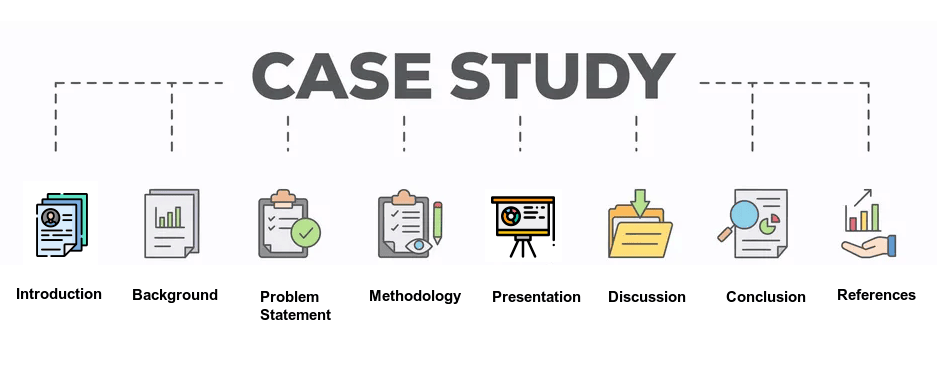Identifying the Subject
Begin by selecting a subject that aligns with your research objectives. Whether it is a business problem, a healthcare challenge, or a social issue, ensure its relevance and significance.
The format of a case study generally follows a structured outline that helps present the information in a clear and organized manner. The main aim of a case study is to extract valuable insights that facilitate a more profound comprehension of the subject matter. A case study is typically structured to provide a comprehensive analysis of a specific subject, which could be an individual, organization, event, or problem. The format may vary based on the case study's purpose and audience, with academic and business case studies often having different emphases. The primary purpose of a case study is to conduct a thorough examination of a specific situation or instance. Essentially, a case study is a form of in-depth research. Crafting an engaging case study is akin to narrating a detective story. When preparing to write a case study, it's crucial to consider the three fundamental steps in case study paper composition: research, analysis, and the actual writing process.

A case study involves analyzing a specific situation and discussing how its different parts relate to established theories. This situation could be real or hypothetical, involving an event, organization, individual, group, or issue. Your task might include solving problems or suggesting future actions based on the case.
A case study is an appropriate research design when you want to gain concrete, contextual, in-depth knowledge about a specific real-world subject. It allows you to explore the key characteristics, meanings, and implications of the case. Case studies are often a good choice in a thesis or dissertation.
As a leading academic service provider, HIGS offers comprehensive assistance for how to write a case study assignment. We understand the significance of effective case study writing and are committed to helping students excel in their academic endeavours. Our expertise extends to providing case study examples for students, ensuring that they have practical models to reference in their assignments. Additionally, we offer short case study sample PDF resources to aid students in understanding the format and structure of a compelling case study. For those seeking case study examples with solutions PDF, we provide insightful case studies with expert solutions to guide students through complex problems. Furthermore, we offer a user-friendly case study template in Word format, making it easier for students to create their case study assignments following the required guidelines. With HIGS, you can enhance your case study writing skills, gain a deeper understanding of case study concepts, and access valuable resources to excel in your academic journey.
Before you begin writing, follow these guidelines to help you prepare and understand the case study:

Begin by pinpointing the central problem or challenge that your case study will address. This core issue serves as the focal point around which your entire case study revolves.
Dive deeper into the issue to uncover its root causes. These triggers could stem from faulty marketing strategies, supply chain inefficiencies, or other contributing factors.
Develop a clear outline for your case study. Determine the key points you intend to cover. Maintain a structured approach, avoiding the mingling of various methods and solutions within the text.
Consider potential solutions that could address the identified problem. Depending on your context, whether you are a student exploring social issues or a business professional analyzing customer challenges, brainstorm and propose applicable remedies.
Begin by selecting a subject that aligns with your research objectives. Whether it is a business problem, a healthcare challenge, or a social issue, ensure its relevance and significance.
Before delving into the case study, gather relevant information about the subject and its context. This step lays the foundation for informed analysis.
Clearly articulate the problem you aim to address. This serves as the focal point of your investigation and guides the entire case study.
Choose the appropriate research methodology that best suits your research goals. Determine whether quantitative data, qualitative insights, or a combination of both will provide the most comprehensive understanding.
Collect data from various sources, both primary (interviews, observations) and secondary (documents, reports). Thorough data collection ensures a robust analysis.
Analyze the collected data to identify patterns, trends, and relationships. Interpret the data in the context of your research question and problem statement.
Propose a solution or approach that addresses the identified problem. Support your solution with evidence from your analysis, explaining why it is a suitable remedy.
Present your findings in a clear and organized manner. Include visuals like graphs or charts to enhance data representation. Summarize your conclusions, tying them back to the problem and solution.

Expert Writers - Our team consists of experienced writers who specialize in case study research across various fields. They have the expertise to craft compelling and well-researched case studies.
Originality Guaranteed - We ensure that every case study is original and thoroughly researched, providing you with content that is both credible and authentic.
Affordable & Timely Delivery - We offer affordable prices without compromising quality and a timely delivery guarantee that the work is completed within your specified deadline.
When creating a case study, adhering to a structured format enhances readability and ensures the content is presented in a coherent manner. Here are 8 steps to help with writing an effective case study presentation
Clearly understand why you are writing the case study and who your target audience is. Determine the tone, style, and content of your case study.
A common structure for a case study is to follow the problem-solution-result format. This structure helps to present a clear narrative and a compelling argument for your case study.
A case study should have a consistent format that makes it easy to read and follow. This includes a title, an executive summary, an introduction, a background, a methodology, a presentation, a discussion, and a conclusion.
A case study should be written in a clear and concise manner that conveys the message effectively and efficiently. Maintaining a logical and well-structured flow in your case study enhances the overall clarity and impact of your work.
A case study should be supported by evidence and examples that illustrate and validate the claims. Evidence can include data, statistics, facts, quotes, testimonials, or case studies from other sources.
Describe the solution or approach you're proposing to address the problem. Explain the rationale behind your choice and how it aligns with the context and analysis.
Thoroughly proofread and edit your case study to eliminate grammatical errors, typos, and inconsistencies. A polished presentation reflects professionalism.
Review and revise it before you submit or publish it. Ensure if your case study meets the requirements and expectations of your purpose and audience.
We know that case study writing can seem difficult and complicated, but we genuinely believe that this guide has addressed most of your inquiries and uncertainties regarding this writing approach. However, if you still find yourself seeking clarity or facing time constraints, it is advisable to consider seeking professional case study assistance. HIGS the best PhD research assistance company is dedicated to providing top-notch case study assistance online, tailored to your unique needs. Our expert team is confident to guide you through the entire process, ensuring your case study not only meets but exceeds expectations. With HIGS by your side, you can be confident that your case study work will stand out as a shining example of research excellence.

Whether it's a case study or any other academic writing, HIGS guarantees 100% originality. Our writers adhere to strict plagiarism guidelines, and we provide convenient plagiarism-checking tools on our platform.
Our team is comprised of skilled researchers and writers who bring extensive experience from diverse fields. This guarantees that your case study is managed by subject matter experts with a deep understanding of the relevant topics.
The presentation of your case study is as important as the content itself. HIGS assists in constructing a coherent and compelling narrative, ensuring your study is clear and impactful.
Unlike other online services, we offer unlimited revisions for your case study if it doesn't meet your requirements. All revisions are provided free of charge, ensuring your complete satisfaction.
We hold our client's privacy in high regard. Your collaboration with HIGS, including your requests and work, remains confidential and undisclosed to any third parties.
We understand that each case study is unique, and there is no one-size-fits-all approach. HIGS offers personalized assistance, ensuring that your case study aligns with your specific goals and requirements.

These are descriptive and aim to provide a detailed account of a particular situation or phenomenon. They help readers understand the context and nuances of the subject.
These case studies serve as examples, often using one or two instances to illustrate a specific condition. They aim to make unfamiliar concepts more relatable and provide a common understanding of the discussed subject.
Conducted prior to major studies, exploratory case studies assist in identifying questions and selecting measurement methods.
These aim to explain causal relationships between variables. Researchers investigate a specific case to understand the reasons behind certain outcomes.
These focus on describing a specific instance or situation, often providing a comprehensive view of the subject.
These studies gather data from various sources over time. They operate on the premise that combining existing research can lead to better generalizations without the need for additional resources for entirely new experiments.
Focusing on specific scenarios of particular interest, these case studies often challenge or confirm generalized claims. They prioritize in-depth analysis over generalizability and are effective for investigating cause-and-effect questions.
Instrumental case studies utilize materials as investigative tools to reveal scientific evidence, with subsequent elucidation of findings for comprehensive understanding.
The length of a case study can vary and depends on factors such as your academic context, subject, and the specific case you're studying. Typically, case studies range from 500 to 1,500 words.
Case study questions are business-oriented situations or challenges presented during the interview for which candidates require to provide solutions. These questions assess a candidate's business acumen, analytical skills and problem-solving capabilities.
A case study is a qualitative research approach where multiple methods of data collection are used for a detailed examination of a single 'case'. A case is a single unit in a study.
A well-structured case study format is essential as it guides readers through a logical flow of information, making the content more comprehensible. It ensures that key points are presented effectively, enabling a clear understanding of the problem, solution, and outcomes.
A comprehensive case study format generally comprises an introduction, background information, problem statement, analysis, solution, results, and conclusion. HIGS ensures that all these elements are meticulously incorporated to create a cohesive narrative.
We understand that institutions and companies might have specific guidelines or templates. Feel free to share these with us, and HIGS will incorporate them into the case study format, ensuring that the final product aligns with your requirements.
Getting started is simple. Reach out to us with details about your project and your desired outcomes. Our team will collaborate with you to and assist you through the process of crafting a compelling and informative case study.
Summary refers to the concise statement or account of the key points of a text, research or essay. The conclusion is that section of the text, essay or book which serves as the final answer to the research question.
Some common sources of a case study include: Interviews, Documents, Archival records, Direct observations and encounters, Participant observation, Facts and statistics, Physical artifacts
At HIGS, we follow a specific citation style such as APA, MLA etc. as per client requirements. In the case study, we use in-text citations and compile a reference list or bibliography at the end. This ensures proper credit to the authors and enhances the study's credibility.